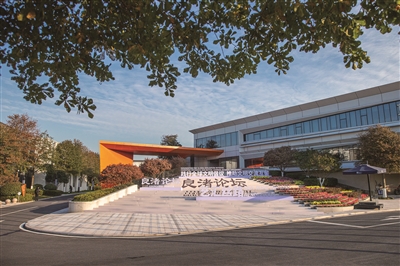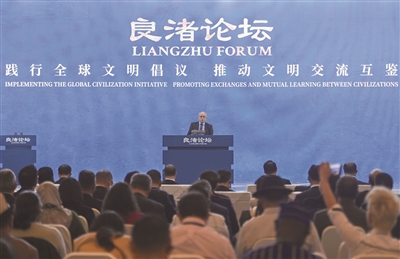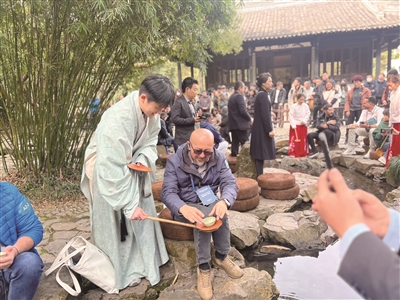
On Dec 3, the "Silk Road Artists' Rendezvous" exhibition, as a key sideline event of the first Liangzhu Forum opened in Hangzhou. Photo: Chen Zhongqiu


Participants attended the Liangzhu Forum after taking trips to explore China. Photo: Xinhua/Yu Xiwen
By Fang Jingyi
On Oct 18, at the opening ceremony of the third Belt and Road Forum for International Cooperation, Chinese President Xi Jinping announced that China would host the Liangzhu Forum to deepen the dialogue on civilization with countries participating in the Belt and Road Initiative. Less than two months later, the forum did take place.
Dialogue on civilizations
Jointly hosted by the Ministry of Culture and Tourism and the People's Government of Zhejiang Province, the first Liangzhu Forum was held on Dec 3.
Xi Jinping sent a congratulatory message to the Forum, emphasizing its significance in implementing the global civilization initiative and promoting exchanges and mutual learning between civilizations.
During the Forum, both the Chinese and international participants were engaged in the in-depth discussions, communications and consensus between global civilizations.
Sub-forums feature civilization
exchanges and mutual learning
Held prior to the launch of the Liangzhu Forum were the two sub-forums featuring culture and arts. The Dialogue of Young Sinologists in the New Era: Civilization Exchanges and Mutual Learning Between China and the World and the Dialogue of the Chinese and International Artists: Civilization Exchanges and Mutual Learning was held on Dec 1 and 2, respectively.
Around 150 participants, including renowned domestic experts, scholars, 43 young sinologists from 33 countries who are part of the 2023 Young Sinologists Training Program and media representatives attended the Forum. The event featured four keynote speeches and two keynote dialogues, where young sinologists from countries such as Kazakhstan, Italy, Austria, Nigeria, Germany, discussed with Chinese experts and scholars on exploring the mutual exchange between the Chinese and foreign civilizations in the context of the Belt and Road Initiative. They also shared viewpoints on the role of the "Cultural Silk Road" in promoting people-to-people connectivity, and the global significance of China's model of modernization.
The forum played a significant role in translating the global initiative on civilization from conceptual ideas into practical actions. Participants expressed that the Liangzhu archaeological site is a testament to China's five-thousand-year civilization, a treasure of world civilizations. Hosting the Liangzhu Forum is deemed crucial for appreciating the charm of ancient civilizations, preserving historical and cultural heritages, and promoting cultural inheritance, development, as well as international cooperation.
On the Dialogue between the Chinese and International Artists: Civilization Exchanges and Mutual Learning, the Vice Chairman of the China Artist Association delivered the keynote speech on What Shall We Present to the World and ten artists from home and abroad presented speeches on Perspectives of Chinese and International Artists on Exchanges and Mutual Learning of Civilization.
Artists enjoy creations inspired
by Liangzhu culture
Eighty-four artists from 83 countries delved into the origins of China's over 5,000-year-old civilization to draw inspirations from the picturesque scenery and create their works for the Silk Road Artists' Exploration Rendezvous Exhibition of Foreign Artists' Drawing about their lives in China. Featuring 152 works and falling into three categories, Origin of Civilization, Lucid Waters and Lush Mountains, and Cultural Legacy, this art exhibition opened as a sub event of the first Liangzhu Forum.
Taking Tomb No. 12 of Fanshan Mausoleum, the highest-level cemetery in the Achaeological Ruins of Liangzhu City as an inspiration, the German artist Tanja used materials such as foil and ink that she brought from Hamburg to project her reflections on the ultimate subject of life and death. Tanja considered her creation as the first introduction into the Chinese culture and found deeper relationships between the ancient Liangzhu people and modern humanity.
Exploring Liangzhu culture has proved to be inspirational for the Omani artist Yousuf Ali Hamed Al-Nahwi when it comes to the historical relationship between China and Oman and Arabian commerce in China depicted in his creations. Al-Nahwi named his work Arabian Commerce in China and said that he would make another work connecting China and Oman together after he goes back to Oman.
The Norwegian artist Esther Maria Bjomeboe said that she has transformed what she has seen and felt into a whisper which is inspired by Chinese culture.
The two dialogues and the exhibition during the Liangzhu Forum are well received by guests and experts. Steven H. Back, the founder and CEO of BRISC, has been living in China for 18 years. As a professional in cultural digitization and exhibition exchange, he believed that this exhibition is very inspirational from the perspective of foreigners and in addition to a diverse range of artistic styles, the inspiration for these works is rooted in the past but is intricately connected to the present and future.
